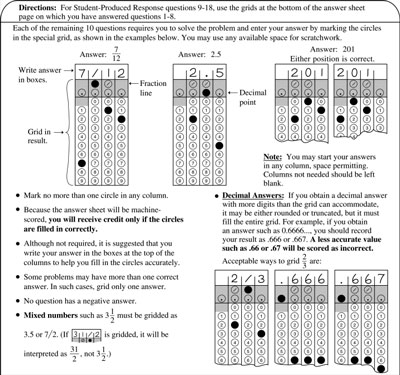|

About SAT Exam
Approaches Student-Produced Responses
Questions of this type have no answer choices provided. Instead, you must solve the problem and fill in your answer on a special grid. Ten questions on the test will be of this type.
On the following pages are five examples of student-produced response questions. Following each question, you will find a solution and at least one way to grid in the correct answer.
It is very important for you to understand the directions for entering answers on the grid!
You will lose valuable testing time if you read the directions for the first time when you take the test. The directions are fairly simple, and the gridding technique is similar to the way other machine-readable information is entered on forms.
A primary advantage of this format is that it allows you to enter the form of the answer that you obtain, whether whole number, decimal, or fraction. For example, if you obtain 2/5, you can grid 2/5. If you obtain .4, you can grid .4. Generally, you should grid the form of the answer that you obtain naturally in solving the problem. The grid will only hold numbers that range from 0 to 9999. Decimals and fractions can also be gridded.
When there is a range of possible correct answers, your gridded response must lie within the range. For example, consider a problem for which all numbers between 4 and 5, exclusive, are correct answers. For this question, although 4.0002 is within the range (4 < x < 5), its rounded value 4.00 is not within the range and therefore would not be considered a correct answer to the problem.

View an actual answer sheet and directions
from a sample test -read them carefully.
|